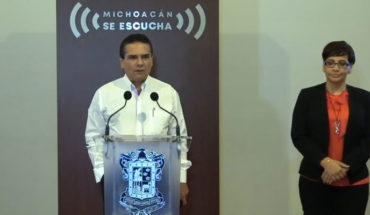The announcement by Mexico City’s head of government, Claudia Sheinbaum, that 800 people will get their release from prisons during the COVID-19 pandemic is not a fact. The decision as to whether or not this is appropriate depends on capital justices who will analyze on a case-by-case basis, and will grant this benefit only if a number of requirements that are required by law are met.
These requirements include that the damage caused by the person has already been repaired, that the person does not pose a potential risk to victims if he leaves prison, and that he has served 75% of the sentence originally imposed in the case of early release.
This was clarified in interview by the Fourth Judge of Execution of Criminal Sanctions of the Judiciary of Mexico City, Karina Becerril Chávez. Sanctions enforcement judges are ultimately responsible for deciding whether a person can be released or not.
“Indeed, some 800 files submitted by the city government are being studied. But the procedure that the law says is respected and in each individual case it is determined whether the person deprived of liberty meets the requirements for obtaining the benefit. It is not enough for the person to be older or have a congenital condition for him to proceed,” he said.
According to official figures, the 800 inmates who can obtain freedom as a target represent 3% of the entire prison population in Mexico City.
On this subject, the Undersecretariat of the Prison System of the Government of Mexico City was also consulted, who confirmed the decision whether or not to release inmates in advance depend exclusively on the judiciary.
Then, Political Animal it details the key points around this capital government plan for 800 inmates to be released in the context of the COVID-19 pandemic.
Who could be released?
According to the information released by the capital government, the 800 applications for early release that have been filed with the city judiciary are related to people who, due to their physical or health condition, may be at greater risk if they become ill with COVID-19.
These are mainly internal and internal elderly or with some risk condition such as pregnancies or some immunodeficiency.
But neither old age nor a physical condition is enough for a person to be released early. Judge Becerril stresses that the inmate in question has to meet the requirements set out in the National Criminal Execution Law (LNEP) to grant this type of benefit. Only those who comply can be released.
Read more: Amnesty’s law will only get 7% of prisoners out of jail and releases would take months
What are the requirements to be met?
Article 141 of the LNEP lays down a number of requirements for an inmate to obtain the benefit of early release, summarising the following:
That the inmate is purging a single sentence and has already served at least 75% of the time of the sentence.
Don’t let the intern be prosecuted for another crime.
That the inmate has already covered the compensation payment of the damage or fine in favour of the victim, and that his freedom does not pose a reasonable risk to him or to all who have testified against him.
That the inmate has shown good behavior during his detention.
In addition, Judge Becerril stressed that only those who have not committed crimes considered serious as organized crime, human trafficking or kidnapping will be able to access this benefit.
What is the procedure for early release?
The judge explained that everything starts with the formal request of the inmate or the government to be granted the release before serving the entirety of his sentence. The petition is then turned over to an executing judge who will be in charge of analyzing it and verifying whether all the requirements are met.
“And then all parties are given intervention. These parties are the Legal Counsel who through a public defender assists the inmate; The Attorney General’s Office with the Public Prosecutor’s Office; and the victim with his legal adviser, whether public or private. The analysis is carried out and finally whether all the points are met, the judge decides whether or not to grant the benefit,” Becerril explained.
On the other hand, the law provides in article 136 a different modality called “conditional freedom”, which allows the inmate to continue his sentence outside of prison, but conditioned on some form of surveillance or control (such as signing a search every day or placing an electronic bracelet) for the remainder of it.
The requirements are those already mentioned in the case of “early release”, but with the difference that the person can apply for it from that he meets half the sentence, as long as the crime is not serious.
Becerril stressed that non-compliance with the obligations imposed on an inmate on probation may result in it being cancelled and the executing judge ordered its re-election.
How many of the 800 have already been released?
According to authorities of the Judiciary of Mexico City, of the nearly 800 files that are under analysis, so far only a third has been considered to be due. The rest is still in study. The capital government said 250 would have already obtained a favorable early release decision.
How many inmates are at high risk for COVID-19?
According to statistics from the Undersecretariat of the Prison System, of the just over 25,000 inmates in Mexico City prisons there are 876 people over 60 years old, of whom 809 are men and 67 are women. Preserving the health of all of them is a priority because, as has already been said, the lethality of COVID-19 in the elderly is much higher.
Another high-risk sector is pregnant women. According to official data in the capital there are nine women in the inside who are in that condition.
In addition, the capital prison system statistic shows that there are 185 inmates infected with HIV – AIDS, which places them as a population of risk due to impacts on their immune system.
All of them would be joined by inmates who suffer from some type of chronic condition such as diabetes or hypertension, but the statistics do not account for them.
It should be noted that so far the Undersecretariat of the Prison System has confirmed only four cases of inmates infected with the virus that causes COVID-19, all newly entered and who remain quarantined.
Would the measure help to depressurize criminals?
The possible release of up to 800 inmates would help reduce the issue of prison overpopulation in the city, only to the extent that the cases are concentrated in the two capital inmates presenting this problem.
Overall the prison population in Mexico City is 25 thousand 41 inmates, which is below the 27 thousand 549 spaces available with which the total 14 detention centers of the capital have in total. In other words, in global terms there is no prison overpopulation.
However, the prison population is not evenly distributed in such prisons. The two largest prisons in the capital do have overpopulation problems.
The Eastern Manly Preventive Reclusory houses 7,184 inmates within an installation designed for up to 6 thousand 92. It equates to an overpopulation of 18%.
While the North Manly Reservoir reported until the end of March last a population of 8,435 inmates, almost 36% above the capacity installed in that center which is only 6,208 places.
The rest of the city’s prisons do not have overpopulation problems.
What we do in Animal Político requires professional journalists, teamwork, dialogue with readers and something very important: independence. You can help us keep going. Be part of the team.
Subscribe to Animal Político, receive benefits and support free journalism #YoSoyAnimal.
translated from Spanish: Judges to decide release of 800 people to CDMX epidemic
May 8, 2020 |





